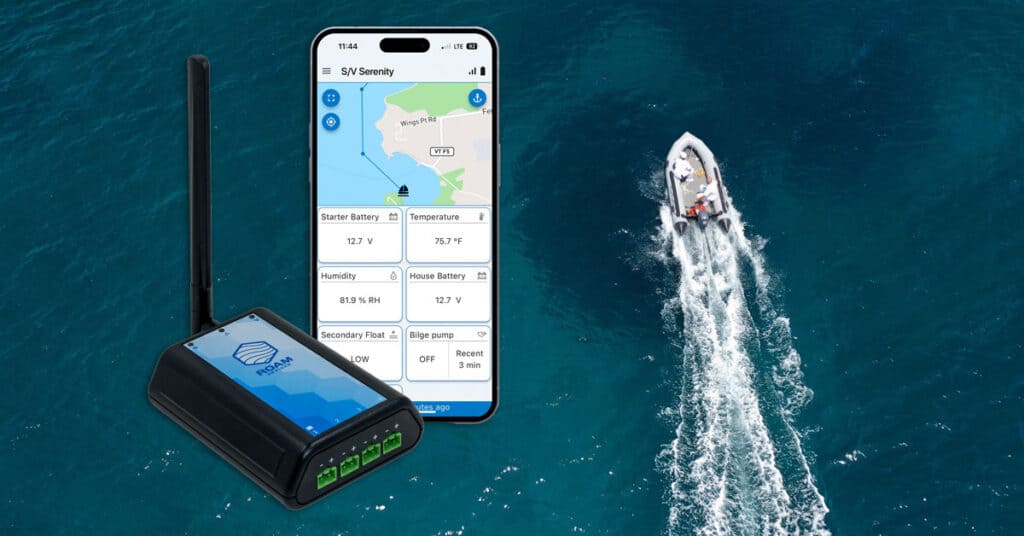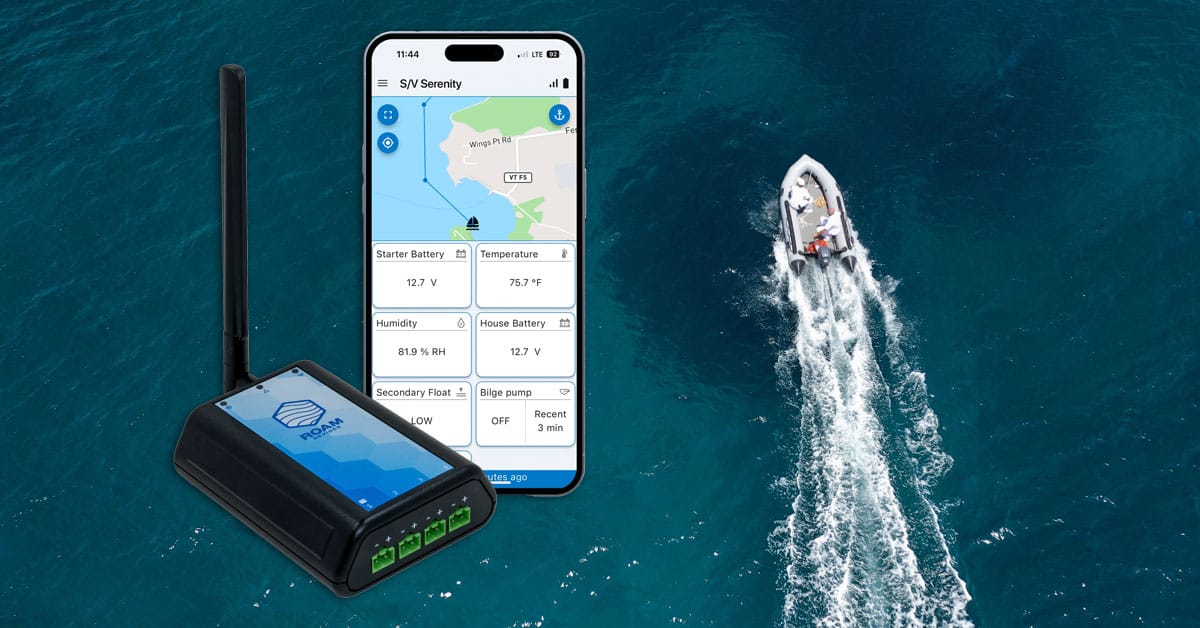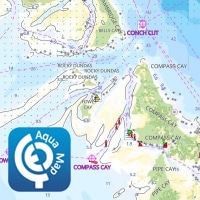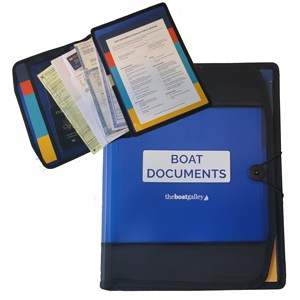This is the Roam Device Review transcript from The Boat Galley Podcast. John Herlig installed the device on his boat and put it through its paces.
Hi, it’s John Herlig from The Boat Galley. I’m here today to talk to you about the Roam marine monitor hub. And I’m the one who’s here to talk to you about it because I have installed one on my boat. I have been a member of the Boat Galley Team for–I don’t know–eight or nine years now. And I represent the frugal cruiser part of The Boat Galley team. I sail on a 1967 Rawson 30 sailboat, a boat without many fancy systems. I’m separated from my boat right now. When Carolyn told me that one of her sponsors was looking for a boat for a test run of a remote monitoring system, I quickly volunteered. The folks over at Roam Devices sent me one of their monitors which I have installed on my boat, Ave del Mar, currently in Florida.
I’d like to walk you through the whole thing. And I can tell you even before I get into the details of it, every step of this was so much easier so much faster and so much simpler than I ever thought it could be.
So some loose concepts first. The remote monitor system, or this one in particular, installs in your boat and monitors vital systems. It connects to a cell network to convey data and then that data is set up into the cloud, and you can retrieve it from an app on your phone.
It comes with a relatively low price point. I believe out of the box it’s about $350 if you order it from RoamDevices.com online.
A couple of things about it really stood out to me. The first is that the price of monitoring the system is like almost nothing. It is $60 a year. So it’s five dollars a month for the ongoing monitoring, or $60 a year, paid by the year. And that is what gets the SIM card activated in the device so it can talk to the local cell network and transfer your data into the cloud system. I was away from home visiting–my boat is not where I live currently–and I had a really narrow window in which to install this into my boat. It was my last day in town and I was heading out of town. I was concerned about how long I had available for the installation. What if I ran into technical problems? Well, let me tell you it was so easy and so fast and so easy to understand how the system works.
So it comes in a relatively small box and the brains of the unit are in a little plastic box about the size of an old computer modem, maybe two 2 1/2 decks of cards. You pull it out of the box, screw in the antenna onto the top, and then the GPS antenna input onto the top. It has a couple of small brackets that will let you install it anywhere on a bulkhead or shelf. You can put it horizontally. You can put it vertically. Mine is actually inside my battery locker because that way it’s right close to the power and it’s easy as can be to screw the brackets into the side and install this in.
It comes with GPS monitoring, a high water alarm, cabin temperature and humidity, and battery voltage. There are a lot of additional monitors that can be added to this: hatch monitors and remote temperature monitors either for an engine room or refrigerator freezer. Also, additional monitoring systems that are not installed on my boat mostly reflecting that my boat has a pretty simple backbone and pretty simple information system onboard.
The monitors just clip in via a little modular plug, sort of like an old television plug. Attach the power cables to the battery and they plug right in. The unit powers up. It connects right with the cellular network and lets you know that it’s working. The GPS monitor is small like a little Sirius or XM radio antenna might have been back in the day. And it comes with a pretty lengthy small cable, (small gauge size) so it’s small, not thick to get it around corners and through holes. But long enough that you can put the GPS antenna somewhere it gets a good read on the GPS satellite.
As this sits in my battery locker it is constantly monitoring the temperature and humidity at the unit–the current state of charge of my battery bank from the battery bank directly. I have a high water switch which is a literal float switch which I got to install in my bilge that simply lets me know from afar that it hasn’t been triggered. And GPS and I’ll go over how all this information comes up from the app in a minute because it’s really, surprisingly powerful and surprisingly, at least it was to me, surprisingly good. I had no reason not to expect it to be good but I was surprised at how sophisticated the systems and how well they work and how much I enjoy having this on my phone and it’s not costing me hundreds of dollars a year to keep it going which I pretty much thought it would.
So this is all installed in the boat and I check it every day, a number of times. Let’s start with, for example, battery voltage. One of the problems I had being away from my boat in summer was when the boat got too hot and my batteries were maintained by a couple of solar panels. I have 230 watts of solar. My batteries, which are flooded lead cell batteries, my batteries ran dry and stopped charging. I wasn’t there. The people I had to occasionally check on my boat were away on deliveries when this happened and none of us had any idea that my batteries had run down. The batteries were incapable of being recharged as they had run dry and my bilge was slowly filling up with water. As I opened the app now there’s a home screen that shows all the monitors that I have installed, which is fewer, perhaps, than a lot of people might. It shows me high water, which is very yes/no very binary–it either has triggered or it hasn’t. It gives me cabin humidity, cabin temperature, GPS location and a map, and battery voltage.
Let’s start with the battery voltage. What I love about this is not only does it tell you currently what your battery voltage is as I’m looking at it during the day. I know it’s probably in the sunlight so that’s going to be trickle voltage if the batteries are full. I’m sure they fill up every day fairly quickly because pretty much all they power is this device and an anchor light. But it also gives you that in graph form. You can look at the past day, the past week, the past month, the past year and what that gives you that is so fantastic is a quick visual reference where you can see your peak charges which are always going to be 14.4 or around there for a traditional battery bank like mine. And then you can see every day when it drops down and they get full and it goes down to trickle charge and it sits there at around 13.4 and then the sun sets and the batteries stabilize and equalize and go back to their charge rate of about 12.6. It would be so easy on this graph, especially if you punch that one month or one year to get a longer data set. It’s so easy to see if you had a low point on the charge that was trending down or substantially lower than it had been and would give you cause to trigger an action to check to see what was going wrong.
I also have an alarm set (all these systems have alarms that can be set) and I have an alarm set on my batteries at 12.3 volts. So regardless of the time of day, if they are on their way up or on their way down, if they don’t have 12.3 volts I’m going to get an alarm which will trigger an alert that will go to my phone. So even if I don’t have the app open and on, I’m going to get that alert to let me know something is wrong.
That battery voltage graph has so far been one of my two favorite things about the Roam Device. The second one is the GPS location and map and anchor alarm that comes with it. Now I don’t have the anchor alarm turned on. My boat has been where she is for a while, but the GPS location shows what I call a breadcrumb history so it has position dots that populate on the map. Every time it takes a reading, which is once every three minutes or so, it’s always telling you where your boat is. On that map, you can map out a one-day, seven-day, one-month, or one-year history of where your boat has been by virtue of its GPS location position and it ends up forming a circle, a dot, if you will. If it’s someplace that is tidal, every six hours my boat is flipping directions and going from the end of its rode to the end of rode the other way. And it has its swing radius which, pretty much fills up instantly. As soon as you hit that thing to a week or a month you can see that history and those dots and see that your boat is well in it and you know are staying inside your historical data set of locations and immediately know that your boat has not dragged at anchor at all. I can open up this app and text one of my friends who lives close to where my boat is and say something like “Oh you guys are getting west winds today” because I’ll see my boat on the GPS map way over at the east end of the anchor swing radius that I get to see, and I know if my boat’s at the east end the boat must be coming out of the west, and you can see all this. The anchor alarm you can actually set as you would any other traditional anchor alarm and it has all of the offsets and adjustables that give you the ability to trigger an alarm that’s gonna let you know if your boat has, in fact, gone wandering.
There are a couple of included sensors for bilge pumps which I don’t have installed on my boat frankly because I just ran out of time. They are not particularly difficult to install. I just happened to be in a hurry that day. But I’ll put them in the next time I go down. But they hook right into the wiring that goes to your main bilge and if that bilge triggers its switch turns it on then this monitoring system wire system will notice the cycle of electricity will record that as a pump activity event and will put it on your on your data set and on your graph. There are monitors that will let you know if a hatch is open or if the humidity is high. I can check shore power, all kinds of things not all of which are pertinent on my boat. I think it will also tie into more modern–more sophisticated–battery monitoring systems, which I also do not have on my boat. But I am getting the information that I need right from that battery voltage usage so I have the app on my phone.
I check it first thing in the morning and I check a couple of times during the day after sunset to see if the batteries are where I expect them to be. So far, not all the news but the best news is that I’m getting all the data I need to begin with. And that $60 hit for an entire year felt like absolutely nothing compared to not knowing that your boat’s filling up with water.
So, for the $349 I think this thing costs off the shelf from Roamdevices.com to the $5 per month that it takes to keep it going to the ease of installation, ease of the understanding, and your ability to manipulate the datasets to get you what you need, I can tell you seriously for me it’s a 10 out of 10. I absolutely love this device. I can’t believe how complicated & expensive I assumed they were and I am so happy that I have mine. This is John Herlig from The Boat Galley reporting on my Roam marine monitor hub and I hope anyone who gets one enjoys it.
The podcast this transcript was taken from was sponsored by Roam Devices.com. Use coupon code BOATGALLEY for an exclusive 5% discount.
Here’s your “Quick Start” to everything you need to know when living on a boat:











Leave a Reply